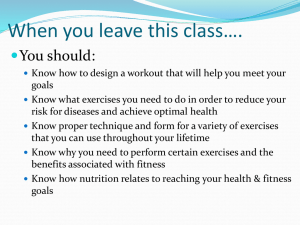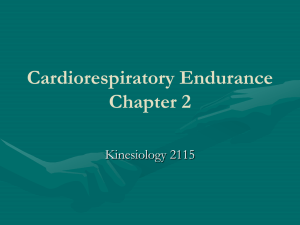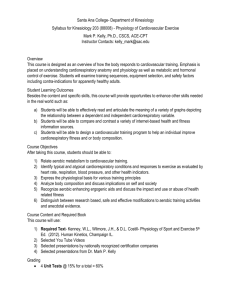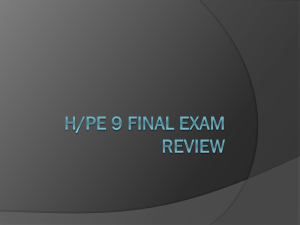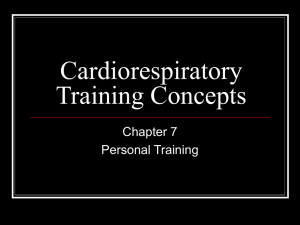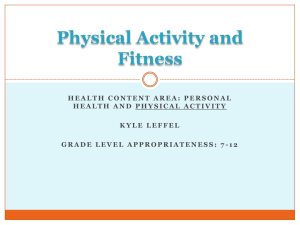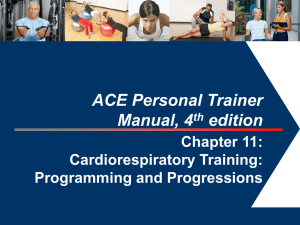cardio
advertisement
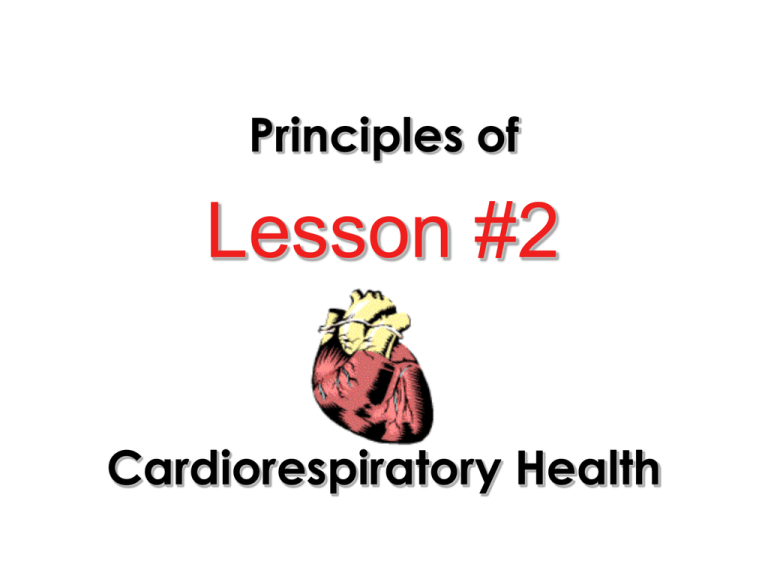
Principles of Lesson #2 Cardiorespiratory Health Cardiorespiratory • The ability of the lungs, heart, and blood vessels to supply the body with sufficient amounts of oxygen to sustain prolonged continuous physical activity. Heart Disease is the number one overall cause of death in North America Cardiorespiratory activities improve the health of the heart thus lowering the chances of Heart Disease Risk Factors for Heart Disease • • • • • • • • Gender Family History Smoking Body Weight Age Exercise Blood Pressure Cholesterol Cardiorespiratory Benefits of Exercise >Active people experience heart disease less often and are less likely to die from heart attacks. >Active people tend to develop extra coronary arteries in the heart. >Heart muscle strengthens. >Concentration, ability to cope with stress, and positive self-concept are improved. Major Cardiovascular Diseases Heart Attack Stroke Peripheral vascular disease (such as atherosclerosis) Hypertension (high blood pressure) Cardiorespiratory Activities • • • • • • • Jogging/Running Swimming Cycling Rowing Skating (not Hockey) Eliptical machines found in Fitness clubs X-Country Skiing Cardio Actvities • Remember the definition of Cardiorespiratory fitness, the activities must: – Be continuous, therefore you cannot stop – Be prolonged, carried out over a significant period of time Most Sports are not good Cardio activities although they may require intensive cardio training Calculating Your Pulse Rate • Locate your pulse in one of two locations: 1. The neck - the carotid artery is the large artery on the front side of the neck next to your Adams apple. Using your first two fingers, gently place them on your neck. You should feel the beat of your heart. 2. The wrist - radial artery. Using your first two fingers, gently place them on the thumb side of your wrist. You should feel the beat of your heart. Heart Rate cont. • Two options: 1) count for 10 seconds and multiply by 6 2) count for 30 seconds and multiply by 2 A typical resting heart rate (RHR) is usually between 66 and 72 beats per minute (BPM) Target Heart Rate Zone (THRZ) • The THRZ represents the heart rate that an individual should have when training if they intend to receive the maximum benefits of Cardio/Aerobic activities • Aerobic is another word for Cardio, it means “with air” Calculating your THRZ • 220 – Age = ____ x 60% = THRZ min. • 220 – Age = ____ x 85% = THRZ max The percentages must be represented as decimals in the equation The final number represents the BPM To find what your 10 second THRZ pulse count should be then divided each number by 6 THRZ • 60 –70 % Max HR= Efficient fat burning zone • 70 – 80% Max HR= Improvement in cardio endurance • 80 – 90% Max HR= Competitive Training Recovery Rate • Check pulse after exercise session, 5 minutes after workout, and 10 minutes after workout • The faster you return to the resting heart rate after exercise, the better your cardiorespiratory health. FITT Formula for Cardiorespiratory Fitness Frequency Intensity 3-5 X/week 60-85% of your Max. Heart Rate (referred to as your Target Heart Rate Zone) Time Type Continuous Activity for at least 20 minutes Jogging, Swimming, Biking, Xcountry skiing The FITT Formula and Cardiorespiratory Training • The FITT formula contains 3 ways in which to Progressively Overload: – Frequency (more times per week) – Intensity (train at a higher THRZ progressively) – Time (increase time incrementally) Frequency • Number of times (x) you exercise per week Depends on individual goals and fitness level • For Aerobic exercise (swimming, jogging, cycling, etc.) benefits achieved at 3X per week minimum. Intensity • Difficulty level at which you exercise per session. Can be determined by Rate of Perceived Exertion (RPE) Scale or Target Heart Rate Zone • Depends on individual goals and fitness level • For Aerobic exercise (swimming, jogging, cycling, etc.) benefits achieved at 60-85% of maximum heart rate Time • Depends on individual goals and fitness level • You may increase the time that you perform cardio exercise or attempt to do more in the same time, thereby increasing intensity For Aerobic exercise (swimming, jogging, cycling, etc.) benefits achieved at 20-30 minutes for Aerobic exercise Review Questions • 1. Cardiovascular fitness is the body’s ability to efficiently pump blood throughout the body. True or False • 2. Which is not a coronary risk factor? a. smoking b. high cholesterol c. moderate exercise d. family history • 3. The benefits of cardiorespiratory exercise are: a. The heart muscle strengthens b. Increase of concentration, stress coping mechanisms, and self concept c. Reduced risk of coronary artery disease d. All of the above Review cont. • 4. The Target Heart Rate Zone is an area where you want your heart rate to be during cardiovascular exercise. True or False • 5. The faster you return to the resting heart rate after exercise, the better your cardiovascular health. True or False 6. F.I.T.T. stands for: a. Fast, Intense, Tough, Tenacious b. Frequency, Inertia, Training, Type c. Free weights, Interval, Time, d. Frequency, Intensity, Time, Type Review cont. 7. The principle of progression states: Your workload must be gradually increased for improvement to occur.True or False 8. Most Sports are excellent cardio activities. T or F
